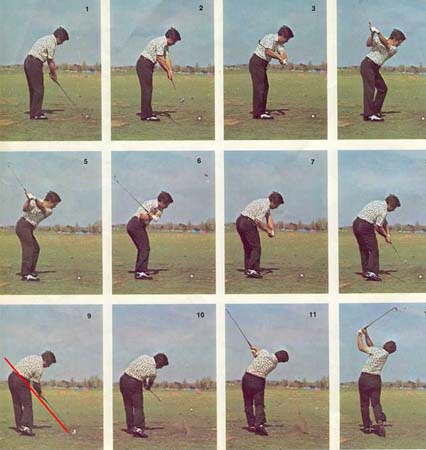I'm sure most of us that have ever taken more than 5 lessons in our lifetime has probably had an instructor say 'you're coming into impact too steep' or 'you're coming into impact too shallow.' The former is more often echoed by instructors. Basically they are saying that the downswing plane is too upright and that's why the golfer catches the ball fat.
But, this never quite made sense to me. For example, Tom Watson's downswing plane was quite upright, yet he almost never takes a noticeable divot.
Or how about Trevino who had a very shallow downswing plane, yet took monster divots.

But then Moe Norman had a very similar downswing plane to Trevino, and almost never took a divot.

I believe that it's simply because each golfer had different attack angles into the ball and attack angle is different from downswing plane and I believe that for the most part, downswing plane doesn't have a thing to do with attack angle and vice versa.
So we've sort explained what he downswing plane is...it's also called the 'vertical swing plane' in Trackman. This is the plane the golfer is on in the downswing. Most golfers are either on the turned shoulder plane or the elbow plane in the downswing.

Attack Angle is measured from the *face on view* and it measures the angle the clubhead comes into the ball at impact.


This is what really correlates to the size of a divot. Trevino with the gargantuan divots had a steep attack angle, but a shallow downswing plane. Moe, who rarely took a divot, had the shallow attack angle and the shallow downswing plane.
A lot of people ask whether or not you should take a big divot and it really depends on what you can do and still hit the ball consistently well. Nobody would tell Trevino to stop taking divots and nobody would tell Moe to start taking divots.
As I've explained in the past, the attack angle also effects the golfers clubhead path thru impact. But we'll save that for another time.
The key here is to understand that attack angle and downswing plane are different and neither really have a lot to do with each other or not as much as most instructors would tell you.
Now, why would somebody like Moe and Trevino have similar downwing planes but vastly different attack angles?
I think (at the moment) it pretty much has to do with the distance of the left shoulder from the ground.
Why?
Because we know that the low point is a point in the ground that is approximately the opposite from the left shoulder. For some golfers it may be a little forward of the left shoulder, for others it may be a little behind the left shoulder.
Low point and attack angle correlate well with each other.
When I talk about 'controlling the Big 3', I mean control of:
- Clubface
- Clubhead Path
- Low Point.
I believe that if you were to hook golfers up with Trackman, the golfers who control the low point well and don't have a lot of thin hits or fat hits usually have a very consistent attack angle with each club they use.
This doesn't mean that each club thru the bag will have the same attack angle. It means that if I have a -5* attack angle with a 6-iron, I will hover around -5* each time I hit that 6-iron. But if I have a -1* attack angle with a 3-iron, then I will hover around -1* each time I hit the 3-iron.
With that, I think consistent attack angles probably have to do with consistently keeping your right shoulder the same distance from the ground at impact.
I believe the following determine the attack angles (besides what club you're hitting):
- Weight at impact
- Ball position
- Axis Tilt at impact
- Center of Gravity
We'll explore this more as I learn more about it.
3JACK
3 comments:
I like this post.
Ralph
Angle of Attack is directly the result of Release Point. Sweep Release for Low Attack Angle and Snap Release for High Angle of Attack.
Divot Depth relies on Ball Location distance from Lowpoint.
You can play the Ball back and have a Low Angle of Attack and play the ball Forward and have a High Angle of Attack.
Thanks anonymous. Need to give your name so I can give credit!
Post a Comment